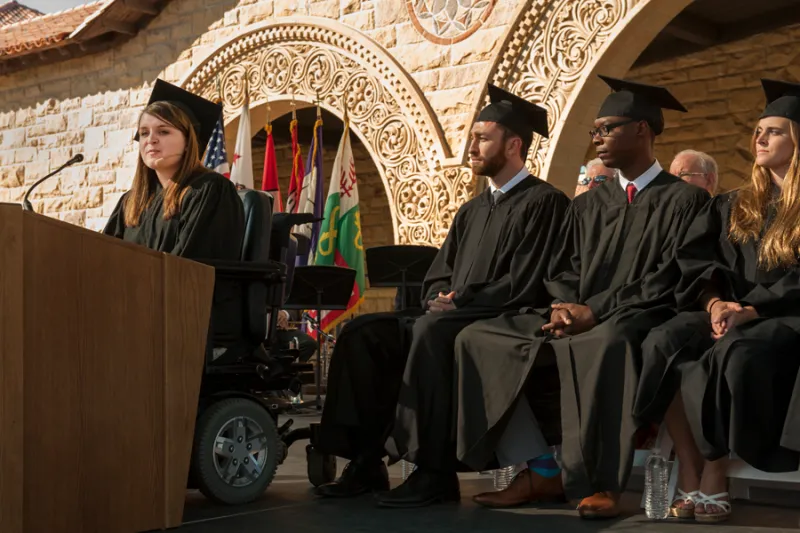As we go about our day-to-day lives, we often encounter certain accommodations in public — ramps, curb cuts, braille on doors and signs — without second thoughts. To thousands of students, there is even the guarantee of employment based on merit, or the accessibility of services like Zoom to have relatively effortless meetings with peers.
But for disabled Americans nationwide, these basic accommodations were neither federally protected nor guaranteed until 30 years ago, when the Americans with Disabilities Act (ADA) of 1990 was signed into law.
The ADA’s five Titles cover a variety of civil rights for employees and individuals with disabilities across the country, ranging from equal employment opportunities to public transportation and accommodations. Title III, for example, necessitates “reasonable modifications” to businesses and public spaces to eliminate barriers for individuals with disabilities. Director Teri Adams of the University Office of Accessible Education (OAE) uses curb cuts as a go-to example of an accommodation whose creation proved beneficial for not just Americans with disabilities, but for abled Americans with strollers or heavy deliveries.
On July 26, the ADA turns 30 years old in the midst of a pandemic and one of the largest rallies for civil rights in history, and it reminds Americans of past cries for equality and equity and the ongoing fight for justice. The ADA — officially created to establish clear-cut protection laws on the basis of disability — was the exclamation mark at the end of a decades-long fight for civil rights. To activists nationwide, the ADA was a “part two” to the landmark Civil Rights Act of 1964, adding disabilities to a growing list of identities to be respected and recognized as equal.
And though the ADA granted full freedom and accessibility to Americans with disabilities like no other statutes, it was not the first law to attack discrimination against disabilities.
The “legal obligation” to mandate accommodations for students with disabilities was triggered by Section 504 of the Rehabilitation Act of 1973, which mandated that the recipients of federal funds could not “discriminate in the delivery of its programs on the basis of disability,” according to Adams.
But the ADA took equity one considerable step further than the Rehabilitation Act. In the words of Sheila Sanchez, who is the Associate Director and ADA Program Director of the Diversity and Access Office at Stanford, the ADA is unique in that it not only prohibits discrimination but requires “reasonable accommodations to people with disabilities.”
“In an employment context, it’s not just enough to say, ‘Oh, well, we can’t discriminate against people with disabilities,’” Sanchez explained. “It goes above and beyond to say, ‘What accommodations might an individual who’s qualified to do a job need in terms of leveling the playing field?’”
And when the ADA finally passed, disability activists and Stanford students alike celebrated the victory and the joy of having their years of work pay off. Cathy Haas, a deaf American Sign Language lecturer at Stanford for over 40 years, encapsulates her reaction to the law in a single word: “happy.”
“All the work we had done for interpreters and the rights for deaf individuals and their needs had paid off,” she said. “And Stanford students too … they were thrilled. Finally, you started seeing the diversity on campus that wasn’t there a long time ago.”
As a teacher who is deaf, the ADA grants Haas a sense of security and belonging on campus. It gives her the freedom and comfort to speak up and ask for accommodations, noting that she is able to request “support, interpreting, services, and captioning” at Stanford due to the ADA. After a prolonged period of having to fight for understanding and recognition, Haas believes the ADA recognizes the need for an “equal amount of respect for an individual who is deaf.”
Associate law professor Rabia Belt, whose Disability Law class is the only one of its kind on campus, says the ADA is designed to ensure that there is not only equality but true equity to ensure a fair game for everyone. The Act strives to “make people with disabilities integrated as part of the world,” she said, and that mandating accommodations and modifications are integral because people with disabilities “were coming into a space that was not designed with them in mind.”
Recognizing the anniversary of the ADA during a global moment of reflection encourages us to look towards the future and acknowledge the need for an “intersectional conversation,” Belt noted. The protests for racial justice must enlarge to “think about disability at the same time.”
“Disabled folks are disproportionately Black and brown, disproportionately poor, disproportionately queer, and disproportionately female,” she added. “In order to get us all into this beloved community, you need to think about disability and ability.”
In addition to being held in the middle of nationwide protests, the ADA’s 30th Anniversary will be celebrated remotely across the country due to the pandemic. Americans with disabilities are significantly more vulnerable to the virus than those without disabilities, and the conversations on how to protect oneself come with the realization that there is a universal danger to be considered, regardless of ability or disability.
“It’s a big anniversary,” Belt said. “As I told my Disability Law class this Spring, we are having a worldwide moment in which we are thinking about how to accommodate the fact that we have fragile bodies … but we have not framed that as a disability conversation. Instead, it does have a lot of resonance [with] the conversation that’s already been happening in the disability community.”
“It’s a fruitful moment, hopefully,” she added.
July 26, 1:30 p.m.: This article has been corrected to change the phrase “hard of hearing” to “deaf,” which is the proper term to use. The Daily regrets this error.
Contact Sophie Sullivan at sophiemsullivan ‘at’ gmail.com.
